

BrainGate. Un article de Wikipédia, l'encyclopédie libre.

Schéma d'une interface neuronale directe BrainGate est un système d'implants neuronaux mis au point par la société de bio-technologie Cyberkinetics en 2003, en collaboration avec le département de Neurosciences à l'Université Brown. Applications[modifier | modifier le code] En pratique[modifier | modifier le code] La puce utilise une centaine d'électrodes chacune épaisse comme un cheveu, qui réagissent à la signature électromagnétique des neurones dans certaines régions spécifiques du cerveau, par exemple la zone qui contrôle les mouvements du bras. Interface neuronale directe. Un article de Wikipédia, l'encyclopédie libre.
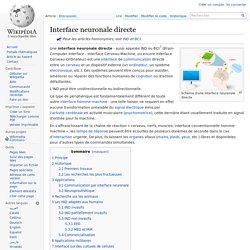
Pour les articles homonymes, voir IND et BCI. Schéma d'une interface neuronale directe Une interface neuronale directe - aussi appelée IND ou BCI[1] (Brain-Computer Interface : Interface Cerveau-Machine, ou encore Interface Cerveau-Ordinateur) est une interface de communication directe entre un cerveau et un dispositif externe (un ordinateur, un système électronique, etc.). Ces systèmes peuvent être conçus pour assister, améliorer ou réparer des fonctions humaines de cognition ou d'action défaillantes. Defense Advanced Research Projects Agency. Un article de Wikipédia, l'encyclopédie libre.

La Defense Advanced Research Projects Agency (DARPA, « Agence pour les projets de recherche avancée de défense ») est une agence du département de la Défense des États-Unis chargée de la recherche et développement des nouvelles technologies destinées à un usage militaire. Jusqu’à aujourd’hui, la DARPA a été à l’origine du développement de nombreuses technologies qui ont eu des conséquences considérables dans le monde entier dont notamment les réseaux informatiques (notamment l’ARPANET qui a fini par devenir Internet) et le NLS (sigle représentant, en anglais, l’expression oN-Line System, en français, littéralement, Système en ligne) qui a été à la fois le premier système hypertexte et un précurseur important des interfaces graphiques devenues omniprésentes de nos jours.
Historique[modifier | modifier le code] Film promotionnel de la DARPA pour son 50e anniversaire en 2008. Neuroprosthetics. Neuroprosthetics (also called neural prosthetics) is a discipline related to neuroscience and biomedical engineering concerned with developing neural prostheses.
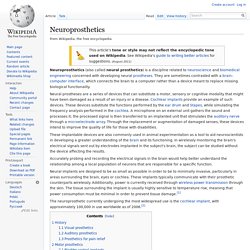
They are sometimes contrasted with a brain–computer interface, which connects the brain to a computer rather than a device meant to replace missing biological functionality. Neural prostheses are a series of devices that can substitute a motor, sensory or cognitive modality that might have been damaged as a result of an injury or a disease. Cochlear implants provide an example of such devices.
These devices substitute the functions performed by the ear drum and Stapes, while simulating the frequency analysis performed in the cochlea. A microphone on an external unit gathers the sound and processes it; the processed signal is then transferred to an implanted unit that stimulates the auditory nerve through a microelectrode array. History[edit] The first known cochlear implant was created in 1957.
Neurodynamics. Brain-to-brain coupling: a mechanism for cre... [Trends Cogn Sci. 2012. Consciousness, group consciousness, mind. Complex-Valued Neural Networks. Blue Brain Project. The Blue Brain Project is an attempt to create a synthetic brain by reverse-engineering the mammalian brain down to the molecular level.
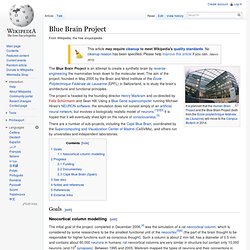
The aim of the project, founded in May 2005 by the Brain and Mind Institute of the École Polytechnique Fédérale de Lausanne (EPFL) in Switzerland, is to study the brain's architectural and functional principles. There are a number of sub-projects, including the Cajal Blue Brain, coordinated by the Supercomputing and Visualization Center of Madrid (CeSViMa), and others run by universities and independent laboratories. Goals[edit] Neocortical column modelling[edit] The initial goal of the project, completed in December 2006,[4] was the simulation of a rat neocortical column, which is considered by some researchers to be the smallest functional unit of the neocortex[5][6] (the part of the brain thought to be responsible for higher functions such as conscious thought).
Progress[edit] By 2005 the first single cellular model was completed. Cognitive neuroscience of human social beha... [Nat Rev Neurosci. 2003. The Blue Brain Project : Abstract : Nature Reviews Neuroscience. Animal Behavior ResearchAnimal behavior research. Transkranielle Magnetstimulation – Wikipedia. De transkranielle Magnetstimulation De transkranielle Magnetstimulation, kuaz TMS, is a ned-invasive medizinische Methode, de wo zua Diagnostik und Therapie vawendt wead.

Mit da Huif vo stoakn Magnetfäida wean Tei vom Hian stimuliat oda ghemmt. De Technologie wead zua Diagnostik und Behondlung vo Tinnitus, Apoplexie, Epilepsie, Parkinson-Kronkheit und fia psychiatirische Sterunga (wia Depression und Schizophrenie) eingsetzt. New technologies for neuromodulation. DSpace@MIT : New technologies for neuromodulation. Neural network. An artificial neural network is an interconnected group of nodes, akin to the vast network of neurons in a brain.

Here, each circular node represents an artificial neuron and an arrow represents a connection from the output of one neuron to the input of another. For example, a neural network for handwriting recognition is defined by a set of input neurons which may be activated by the pixels of an input image. After being weighted and transformed by a function (determined by the network's designer), the activations of these neurons are then passed on to other neurons. This process is repeated until finally, an output neuron is activated. This determines which character was read. Like other machine learning methods - systems that learn from data - neural networks have been used to solve a wide variety of tasks that are hard to solve using ordinary rule-based programming, including computer vision and speech recognition.
Computational neuroscience. Computational neuroscience is the study of brain function in terms of the information processing properties of the structures that make up the nervous system.[1] It is an interdisciplinary science that links the diverse fields of neuroscience, cognitive science, and psychology with electrical engineering, computer science, mathematics, and physics.
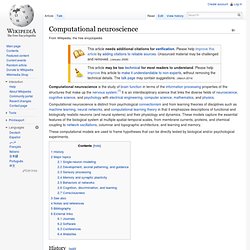
Computational neuroscience is distinct from psychological connectionism and from learning theories of disciplines such as machine learning, neural networks, and computational learning theory in that it emphasizes descriptions of functional and biologically realistic neurons (and neural systems) and their physiology and dynamics. These models capture the essential features of the biological system at multiple spatial-temporal scales, from membrane currents, proteins, and chemical coupling to network oscillations, columnar and topographic architecture, and learning and memory. Neurophysics. Neurophysics (or neural physics) is the branch of biophysics dealing with the nervous system including the brain and the spinal cord and the nerves.

The term is a portmanteau of neurology and physics, to represent an emerging science which investigates the fundamentally physical basis for the brain, hence the basis for cognition. The field covers a wide spectrum of phenomena from molecular and cellular mechanisms to techniques to measure and influence the brain and to theories of brain function. It can be viewed as an approach to neuroscience that is based on solid understanding of the fundamental laws of nature. Quantum mind. The quantum mind or quantum consciousness hypothesis proposes that classical mechanics cannot explain consciousness, while quantum mechanical phenomena, such as quantum entanglement and superposition, may play an important part in the brain's function, and could form the basis of an explanation of consciousness.
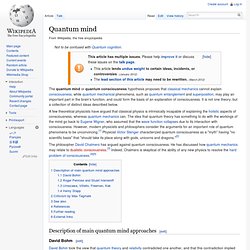
It is not one theory, but a collection of distinct ideas described below. A few theoretical physicists have argued that classical physics is intrinsically incapable of explaining the holistic aspects of consciousness, whereas quantum mechanics can. The idea that quantum theory has something to do with the workings of the mind go back to Eugene Wigner, who assumed that the wave function collapses due to its interaction with consciousness. The philosopher David Chalmers has argued against quantum consciousness. Brain activity during observation of actions. Influence of action content and subject's strategy.
Neurowar. Brain-mapping. Neuromarketing. Mind_control.